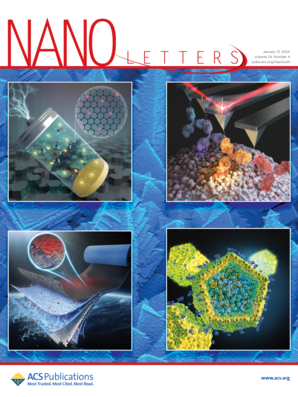Strain Soliton Activated Gliding for Length Invariant Friction.
IF 9.6
1区 材料科学
Q1 CHEMISTRY, MULTIDISCIPLINARY
引用次数: 0
Abstract
In the prevailing paradigm of tribology, a long filament in a bundle is asymptotically confined by friction, which rises and theoretically diverges with the filament length. Here, we provide an analytical solution that the stress at the trailing end can nonlinearly penetrate into the bulk region to neatly form strain solitons, which then propagate with no energy cost to activate the gliding motion of the slider and, thus, a length invariant friction. Such a motion is demonstrated by coarse-grained simulations in carbon nanotubes under both quasi-static and dynamic loading conditions. We also derive that the ratio of intrinsic elasticity and interfacial stiffness dictate the scope of the length invariant frictional regime and transitions to smooth sliding or stick-slip regimes. These findings not only align with previous experimental observation but also enrich the fundamental knowledge of ubiquitous frictional sliding in both natural and artificial systems.长度不变摩擦的应变孤子激活滑动。
在流行的摩擦学范式中,束中的长纤维受到摩擦的渐近限制,摩擦随纤维长度的增加而增加,理论上也会发散。在此,我们提供了一个解析解,即尾部的应力可以非线性地渗透到体区,整齐地形成应变孤子,然后在不消耗能量的情况下传播,以激活滑块的滑动运动,从而产生长度不变的摩擦。在准静态和动态加载条件下,对碳纳米管进行了粗粒度模拟,证明了这种运动。我们还推导出固有弹性和界面刚度的比值决定了长度不变摩擦状态的范围以及向光滑滑动或粘滑状态的过渡。这些发现不仅与以往的实验观察相一致,而且丰富了自然和人工系统中普遍存在的摩擦滑动的基本知识。
本文章由计算机程序翻译,如有差异,请以英文原文为准。
求助全文
约1分钟内获得全文
求助全文
来源期刊

Nano Letters
工程技术-材料科学:综合
CiteScore
16.80
自引率
2.80%
发文量
1182
审稿时长
1.4 months
期刊介绍:
Nano Letters serves as a dynamic platform for promptly disseminating original results in fundamental, applied, and emerging research across all facets of nanoscience and nanotechnology. A pivotal criterion for inclusion within Nano Letters is the convergence of at least two different areas or disciplines, ensuring a rich interdisciplinary scope. The journal is dedicated to fostering exploration in diverse areas, including:
- Experimental and theoretical findings on physical, chemical, and biological phenomena at the nanoscale
- Synthesis, characterization, and processing of organic, inorganic, polymer, and hybrid nanomaterials through physical, chemical, and biological methodologies
- Modeling and simulation of synthetic, assembly, and interaction processes
- Realization of integrated nanostructures and nano-engineered devices exhibiting advanced performance
- Applications of nanoscale materials in living and environmental systems
Nano Letters is committed to advancing and showcasing groundbreaking research that intersects various domains, fostering innovation and collaboration in the ever-evolving field of nanoscience and nanotechnology.
 求助内容:
求助内容: 应助结果提醒方式:
应助结果提醒方式:


